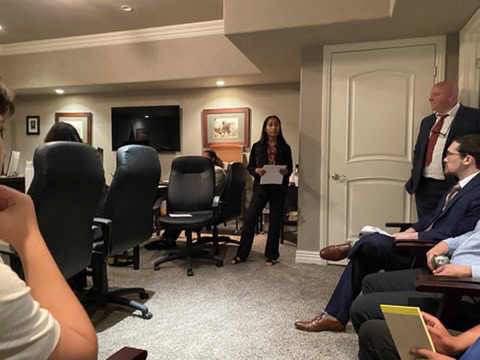San Bernardino Superior Court will spend $629,014 of one-time state technology modernization funding on residents’ and judges’ online access to case documents and services.
The updates to the Court Access Portal will allow residents to pay fees and fines, and to file case information if they are representing themselves, at an estimated project cost of $296,252, according to the court’s funding application.
“San Bernardino County is larger than New Jersey, Connecticut, Rhode Island and Delaware combined, and is divided by a vast mountain range. Our success in delivering justice to rural and urban residents alike depends on laws and procedures well suited to remote proceedings”
Mariano-Florentino Cuéllar, former California Supreme Court justice
“There is a reasonable expectation to get this stuff done online,” said Kyle Brodie, San Bernardino Superior judge and Judicial Council Technology Committee chair, by phone. “We recognize this is where we need to go.”
The court plans to supplant paper case files, and replace the judge’s scarcely-used electronic document access tool, with a new case management system at an estimated cost of $737,008. The court will finish supporting the projects with local funds, according to Julie Van Hook, court communications and public affairs officer, by email.
Riverside Superior Court did not apply to the funding pool because of a sudden loss of 200 employees which narrowed the court’s focus to running operations, according to Marita Ford, Riverside Superior Court public information officer and chief deputy of finance and resources, by email. The court is currently migrating their juvenile, criminal and traffic cases’ management system to eCourt, Ford wrote.
Online access
“The court technology modernization funding recognizes that technology for the judicial branch is not just about increasing convenience to the public, it is that, of course, but it also allows for several different channels of access to justice,” Brodie said at a Judicial Council meeting Oct. 1.
The Court Access Portal updates are intended to increase online access to justice, because physical access to courtrooms can be difficult in the 20,000-square mile San Bernardino County, the application reads. The county is the largest county in the United States, and larger than nine states.
The project also calls for new kiosks in courtrooms for people to access and submit case information or pay fines, if they choose to not use the portal. The court currently uses the Tyler Odyssey Public Portal, which the updates will build upon instead of replace, according to Brodie.
Judicial management tool
Judges can currently use the Tyler Odyssey Judge Edition to view case documents on computers, but a lack of features and customization options has made the service scarcely used, according to the court’s funding application. The details of the project are being decided now, with input from judges, according to Brodie.
Hearings will be more efficient after the project, as judges will not be as dependent on a physical court file, the application reads. The project will also open the door to an electronic discovery process, the application says.
Funding source
The Judicial Council administered the funding from the second $25 million allocation in California’s budget intended to modernize courts over the past two years. The council provided $15 million to local courts, and spent the other $10 million on branch-wide initiatives that the local courts can use.
The council used the money to develop online chatbots, voice-to-text translation services at court counters, data analytics and court websites. Three of their programs were entirely developed by the court system: the case management system, CourtStack; emailed and texted public reminders via Court Notify; and a transcript-to-online program, Transcript Assembly Program.
San Bernardino Superior Court also applied for, but did not receive, funding to two lower-priority projects: $132,920 to back up court files on the cloud instead of local tapes, which could be damaged during a regional disaster, and $100,000 to digitize a backlog of 1.68 million physical documents.
Wide agreement on program
Mariano-Florentino Cuéllar, the former California Supreme Court justice, argued in a recent commentary, which mentioned San Bernardino County, that remote operations should be a major channel for resolving justice.
“First, courts must increasingly treat remote operations as a major—and in some situations, the primary—channel,” Cuéllar wrote.
“Courtrooms will remain iconic settings, but a sprawling country demands a judiciary well suited to resolving disputes without forcing people to spend half their day or more in transit. Here in California, San Bernardino County is larger than New Jersey, Connecticut, Rhode Island and Delaware combined, and is divided by a vast mountain range. Our success in delivering justice to rural and urban residents alike depends on laws and procedures well suited to remote proceedings.”
The judicial council touted the benefits of remote resolution in an Aug. 16 report.
“Providing access to the courts through the use of remote technology is an access to justice issue,” the report reads.
Forty million individuals visited courts before the pandemic, but 75 percent of self-help visitors chose to use remote services when offered, the report reads, indicating that remote proceedings will reduce traffic and pollution.
Related: Efficiency Act brings technology, remote proceedings, to courts post-pandemic
[/wlm_private]







